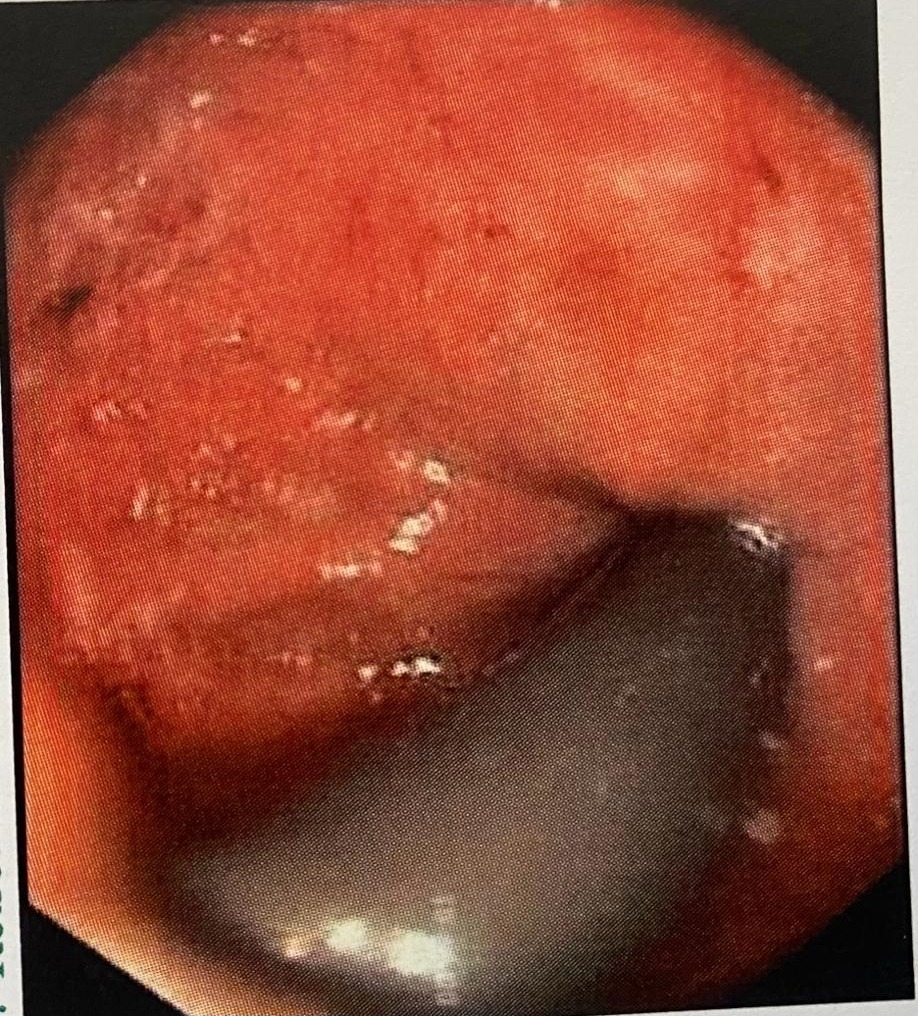Sunday Poster Session
Category: IBD
P0812 - A Rare Case of Mesalamine-Induced Myocarditis in a Patient With Ulcerative Colitis
Sunday, October 22, 2023
3:30 PM - 7:00 PM PT
Location: Exhibit Hall

Has Audio

Amaar Ahmad, DO
Saint Michael's Medical Center
Newark, NJ
Presenting Author(s)
Amaar Ahmad, MD1, Saraswathi Lakkasani, MD2, Muhammad Hussain, MD2, Byron Okwesili, MD2, Mehul Shah, MD1
1Saint Michael's Medical Center, Newark, NJ; 2Saint Michael's Medical Center, New York Medical College, Newark, NJ
Introduction: Mesalamine is commonly used as induction and maintenance therapy for mild to moderate ulcerative colitis. The most common side effects of mesalamine include nausea, vomiting, abdominal pain, headache and skin rash. Rare side effects include pancreatitis, nephrotoxicity and cardiotoxicity. Cardiotoxic side effects that have been reported include pericarditis, myocarditis, coronary vasculitis and left ventricular dysfunction. Here, we are reporting a case of a 51-year-old man who developed myocarditis with reduced ejection fraction and cardiomyopathy caused by mesalamine treatment for newly diagnosed ulcerative colitis.
Case Description/Methods: A 51-year-old male with a past medical history of HTN, HLD, and hypothyroidism presented to the office with complaints of rectal bleeding and diarrhea. The patient underwent colonoscopy with biopsies revealing ulcerative colitis and was started on mesalamine 800 mg three times daily. One week later, the patient returned to the office with worsening symptoms. The dose of mesalamine was increased to 1.6 g three times daily and prednisone 20 mg twice daily was added. Two weeks later, the patient presented to the emergency department complaining of chest pain and continued bouts of intermittent diarrhea associated with urgency. Patient started on hydrocortisone 100 mg IV every 8 hours and continued on mesalamine 1.6 g three times daily. Cardiac workup showed elevated troponins and CT Angiogram of the abdomen and pelvis showed pancolitis and negative for aortic pathology. Cardiology was consulted and the patient underwent cardiac catheterization which revealed mild non-obstructing coronary artery disease and Type 2 non-ST segment elevation myocardial infarction. The Echocardiogram showed global left ventricle hypokinesis, ejection fraction of 30-35%, mild to moderate mitral regurgitation and grade II diastolic dysfunction. The patient was diagnosed with myocarditis and suspected cardiomyopathy secondary to mesalamine. At this time the mesalamine was discontinued. The echocardiogram was repeated six days later showing an ejection fraction of 55-60% with improving left ventricular function. His symptoms had been improving and denied abdominal pain, nausea, diarrhea or rectal bleeding. The patient was tapered from prednisone and started on vedolizumab.
Discussion: This case reinforces the significance of rare but potential side effects observed with mesalamine use in UC patients and can aid clinicians in prompt diagnosis and management to avoid complications.

Disclosures:
Amaar Ahmad, MD1, Saraswathi Lakkasani, MD2, Muhammad Hussain, MD2, Byron Okwesili, MD2, Mehul Shah, MD1. P0812 - A Rare Case of Mesalamine-Induced Myocarditis in a Patient With Ulcerative Colitis, ACG 2023 Annual Scientific Meeting Abstracts. Vancouver, BC, Canada: American College of Gastroenterology.
1Saint Michael's Medical Center, Newark, NJ; 2Saint Michael's Medical Center, New York Medical College, Newark, NJ
Introduction: Mesalamine is commonly used as induction and maintenance therapy for mild to moderate ulcerative colitis. The most common side effects of mesalamine include nausea, vomiting, abdominal pain, headache and skin rash. Rare side effects include pancreatitis, nephrotoxicity and cardiotoxicity. Cardiotoxic side effects that have been reported include pericarditis, myocarditis, coronary vasculitis and left ventricular dysfunction. Here, we are reporting a case of a 51-year-old man who developed myocarditis with reduced ejection fraction and cardiomyopathy caused by mesalamine treatment for newly diagnosed ulcerative colitis.
Case Description/Methods: A 51-year-old male with a past medical history of HTN, HLD, and hypothyroidism presented to the office with complaints of rectal bleeding and diarrhea. The patient underwent colonoscopy with biopsies revealing ulcerative colitis and was started on mesalamine 800 mg three times daily. One week later, the patient returned to the office with worsening symptoms. The dose of mesalamine was increased to 1.6 g three times daily and prednisone 20 mg twice daily was added. Two weeks later, the patient presented to the emergency department complaining of chest pain and continued bouts of intermittent diarrhea associated with urgency. Patient started on hydrocortisone 100 mg IV every 8 hours and continued on mesalamine 1.6 g three times daily. Cardiac workup showed elevated troponins and CT Angiogram of the abdomen and pelvis showed pancolitis and negative for aortic pathology. Cardiology was consulted and the patient underwent cardiac catheterization which revealed mild non-obstructing coronary artery disease and Type 2 non-ST segment elevation myocardial infarction. The Echocardiogram showed global left ventricle hypokinesis, ejection fraction of 30-35%, mild to moderate mitral regurgitation and grade II diastolic dysfunction. The patient was diagnosed with myocarditis and suspected cardiomyopathy secondary to mesalamine. At this time the mesalamine was discontinued. The echocardiogram was repeated six days later showing an ejection fraction of 55-60% with improving left ventricular function. His symptoms had been improving and denied abdominal pain, nausea, diarrhea or rectal bleeding. The patient was tapered from prednisone and started on vedolizumab.
Discussion: This case reinforces the significance of rare but potential side effects observed with mesalamine use in UC patients and can aid clinicians in prompt diagnosis and management to avoid complications.

Figure: Retroflexion view of rectum with ulceration and inflammation.
Disclosures:
Amaar Ahmad indicated no relevant financial relationships.
Saraswathi Lakkasani indicated no relevant financial relationships.
Muhammad Hussain indicated no relevant financial relationships.
Byron Okwesili indicated no relevant financial relationships.
Mehul Shah indicated no relevant financial relationships.
Amaar Ahmad, MD1, Saraswathi Lakkasani, MD2, Muhammad Hussain, MD2, Byron Okwesili, MD2, Mehul Shah, MD1. P0812 - A Rare Case of Mesalamine-Induced Myocarditis in a Patient With Ulcerative Colitis, ACG 2023 Annual Scientific Meeting Abstracts. Vancouver, BC, Canada: American College of Gastroenterology.
